Oracle Partner PaaS Workshop (day 2 – part 1) – MCS and MAX
Last week I attended a two-day PaaS workshop run by Oracle for its partners. We’ve been doing SaaS for a while – that is the applications such as HCM and ERP that users access in order to perform their daily tasks – however there is another stable of applications called Platform as a Service (PaaS) which either add functionality to the SaaS apps or help ‘glue them together’. These applications were the focus of this workshop – and very interesting it was too. Here’s what I learnt on day 2:
Oracle MCS (Mobile Cloud Service)
On day 1 we’d exposed a web service from an application and added some logic, notifications and a data form in front of it using ICS and PCS. Next we used Mobile Cloud Service to mobile-enable the form. MCS exposed the form as a mobile API which we could then consume.
Oracle MAX (Mobile Application Accelerator)
A reasonably new feature of Oracle MCS is the Mobile Application Accelerator. Most of those in the workshop were techies, but there wasn’t the time to code a proper front-end for our new mobile API. The solution was to use MAX. It’s a tool built to assist a non-technical staff to create cross-platform mobile applications using only a drag’n’drop web
interface:

Within a couple of minutes, the application that we’d created was available and working on our mobile phones. We could enter the data for a new purchase order and within moments the data appeared in ERP Cloud.
Oracle Partner PaaS Workshop (day 1) – ICS and PCS
Last week I attended a two-day PaaS workshop run by Oracle for its partners. We’ve been doing SaaS for a while – that is the applications such as HCM and ERP that users access in order to perform their daily tasks – however there is another stable of applications called Platform as a Service (PaaS) which either add functionality to the SaaS apps or help ‘glue them together’. These applications were the focus of this workshop – and very interesting it was too. Here’s what I learnt on day 1:
Oracle ICS (Integration Cloud Service)
ICS is a Cloud-based integration platform which comes with a decent set of pre-built adapters. If you’re concerned with the cost of custom integration to stitch together your Cloud and on-premises applications then ICS – which comes with a host of ready-to-use integration points could help.
The version I saw had around 50 adapters allowing you to retrieve data from, or send data to, systems such as Concur, LinkedIn, NetSuite, SalesForce, SAP, SuccessFactors, plus all the major databases and – of course – Oracle Cloud apps such as HCM Cloud and ERP Cloud.
Here’s a screenshot from the lab where within a few minutes we drag’n’dropped to create a REST interface to add a purchase order via the pre-built ERP Cloud connector:
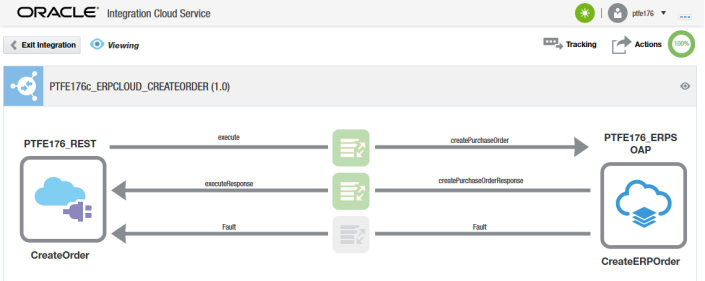
Find out more here.
Oracle PCS (Process Cloud Service)
PCS is a Cloud-based integration platform that allows you to move the data between the end-points exposed by your various systems (or by ICS). If you can imagine the point-and-click screens that your systems have to configure workflow, this looks very similar but works across all the systems in your estate.
In the workshop we tried adding processes, forms, conditional rules and notifications:
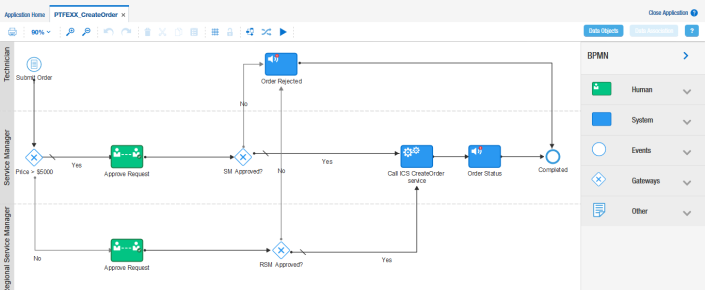
The Eagerly Awaited Internet Trends Report 2017
 Every year, Mary Meeker – partner at Kleiner Perkins Caufield & Byers – releases her ‘Internet Trends Report’. It is probably the most eagerly awaited slide deck of the year (alongside Stacey Harris’ HR Systems Survey and Research report – which if you haven’t yet filled it in, you can do so here). Mary’s Internet Trends report gives a facts and figures based summary of the current state of the marketplace, and predicts how that’ll change over the coming years. It’s lengthy, but always a treasure trove of information.
Every year, Mary Meeker – partner at Kleiner Perkins Caufield & Byers – releases her ‘Internet Trends Report’. It is probably the most eagerly awaited slide deck of the year (alongside Stacey Harris’ HR Systems Survey and Research report – which if you haven’t yet filled it in, you can do so here). Mary’s Internet Trends report gives a facts and figures based summary of the current state of the marketplace, and predicts how that’ll change over the coming years. It’s lengthy, but always a treasure trove of information.
The slide deck can be found here, however I’m going to highlight a few items of interest and point out how they’re relevant in the world of Oracle.
Mobile vs Internet use
Both mobile and internet use are still on the rise, however the increase in mobile handset shipments is decelerating. Are we approaching saturation point with mobiles? There are 3.4Bn internet users – approx half of the World’s population – and this is increasing by 10% each year, with the number of mobile handsets shipped at just below 1.5Bn – with more than 80% of those Android.
What’s also intriguing is the number of hours spent each day using your mobile is now averaging 3.1 hours (up from 0.3 hours 8 years ago), however this isn’t coming at the expense of Desktops/Laptops (which averaged 2.2 hours last year and 8 years ago). So the amount of time we spend interacting with digital media has increased hugely in that time.
Oracle slant:
Oracle has improved the responsiveness of the HCM Cloud in recent versions, and this is – rightly – going to continue in future releases. It’s important that the desktop interface is still improved at the same rate, as the figures show that isn’t declining.
Conversational Input
The report states that 20% of searches are now performed by voice command, rather than text input. In the age of Siri/Google Assistant/Alexa this should be no surprise, but it does illustrate that we’re on a path towards voice interfaces being more commonplace. The accuracy of systems understanding voice commands is also on the increase – it’s now around 95% (which is about the same as humans).
Oracle slant:
Clearly chatbots (whether interacted with via voice or by typing text) are the future for much of HR Self Service interactions.
Doormen = Foremen
We were tickled by the pictures of doormen in apartment blocks becoming more like foremen and needing a room to use as a warehouse for holding all the parcel deliveries that come in via the post for residents each day.
Augmented Reality
Lowe’s Augmented Reality app to provide in-store directions to goods on their shelves is very cool.
Oracle slant:
Augmented/Virtual Reality is going to be important in the field of learning. Most people learn better by ‘doing’, so a situation where trainees can perform a task in a virtual environment – free of consequences if they make mistakes while learning – is a useful tool. I’m not sure we’ll see AR/VR in HCM Cloud any time soon though.
Instant Gratification and Gaming
Millennials are growing up surrounded by gamification, and apps and games that give instant feedback by ‘levelling up’ quickly. Different games are preferred by the generations, but many of the mechanics that drive players to return are consistent across the games. We’ve all seen sites that rank your profile as XX% complete, but what is newer is the rise of services such as Twitch – where live games are streamed to interested viewers – which is considerably more popular amongst younger generations than older people. An example of this it the recent League of Legends World Championship received 43 million unique viewers.
Oracle Slant:
Oracle Cloud Connect now highlights its top 10 users of the month, rewarding those who’ve put effort in to the platform. Instant feedback is also coming to the HCM Cloud, in the form of kudos now becoming real-time performance feedback, rather than the annual routine that we used to follow.
Developer / Designer Ratios
A short topic that caught my eye was the change in Designer vs Developer ratios over the last 6 years. Back then, companies such as Atlassian, IBM and LinkedIn reported ratios of 1:25, 1:72 and 1:11 respectively, with Developers far outnumbering Designers. The ratio has moved in significantly however, with companies now reporting a ratio of between 1:5 and 1:9.
Oracle Slant:
Oracle’s Apps UX team have been at the forefront of designing the HCM Cloud user experience, and can be seen at most Oracle events evangelising the design paradigms that they’ve used in this process.
The Rise of Digital Healthcare
The number of companies that focus on personal health has grown very rapidly, but this growth isn’t just in the field of wearables, as one might expect. Companies offering health-related datasets to dramatically reduce the time needed for clinical trials (and hence speeding time-to-market), patient Electronic Health Records and tests for genetic disorders that you can take via the mail (e.g. 23andMe) are all areas of growth.
Oracle Slant:
Oracle HCM Cloud has a whole module for this, My Wellness.
Free Oracle HCM Cloud backgrounds
It’s a common practice to change the background colour of your environments to give a visual clue which is which. This helps reduce confusion and lessens the risk of entering test data into Production.
Whilst the core project team might easily remember which colour corresponds to which environment (e.g. blue=Prod, red=Dev, green=Test) it’s not so easy for more occasional users. There is a solution for this.
We’ve created some semi-transparent backgrounds that prominently feature the name of the environment. They’re semi-transparent so that your background colour of choice can still show through. Here’s what they look like:
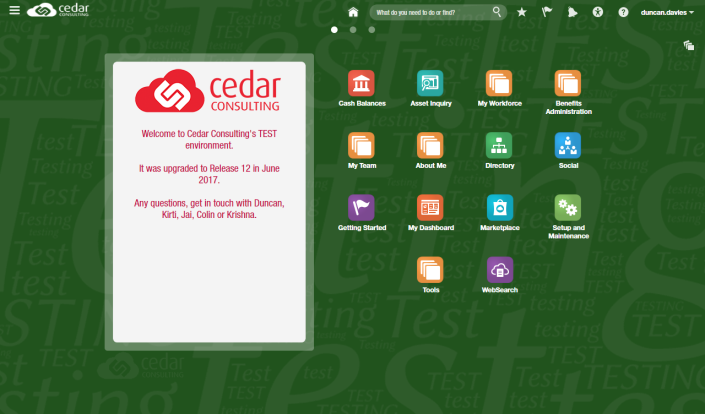
You should be able to see the words Test and Testing on top of the green background. This gives less frequent users more certainty they’re logged on to the correct environment. I’ve chosen a green background colour here, but any (reasonably dark) colour can be chosen and the lettering will still show.
Here is the Development background image on top of a red background colour.

The images work with both Release 11 and 12, and can be downloaded here:
Remember, the lettering is semi-transparent so they might look like a blank image until you select a background colour behind them:
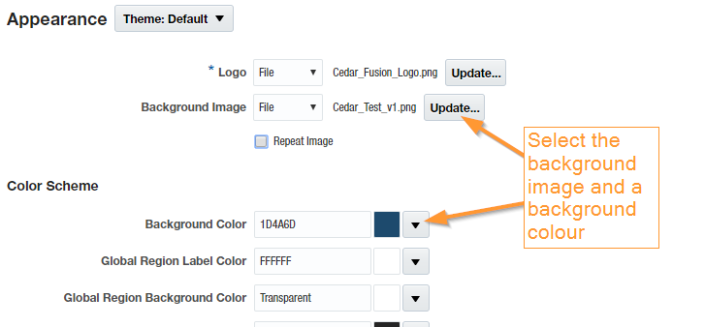
I’d be happy to create additional environment backgrounds if enough people show an interest.
Cedar’s Oracle Talent Acquisition Cloud Event / Team
Earlier this week Cedar held its Oracle Talent Acquisition Cloud event in Oracle’s London City office. We have a really strong team of UK-based Talent Acquisition specialists within our ranks:
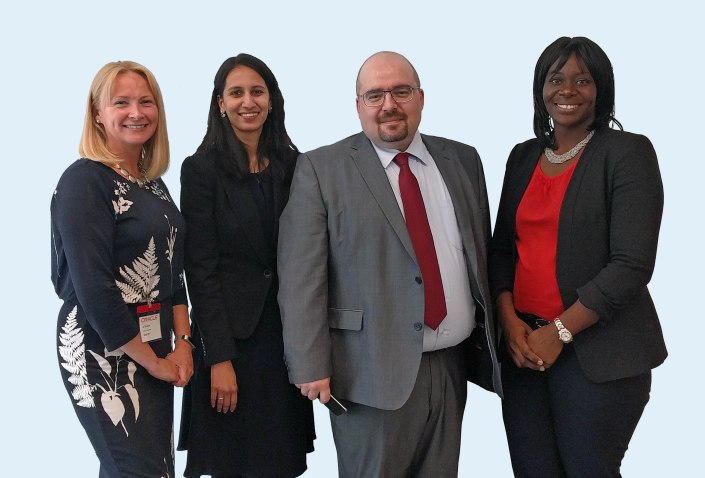
Jo, Prachi, Marc and Mel are all experts in the various aspects of Oracle Talent Aquisition Cloud – Taleo Recruit, Sourcing and Onboarding – and Cedar has multiple implementations under our belt covering all of the above products, so we were able to put on a seminar with strong content.
I’ve put a post on the Cedar blog with lots of photos from the day here.
HCM Cloud vs Workday – the Latest Figures
Both Oracle and Workday have recently announced figures for their Cloud application suites and it’s interesting to see how they both compare.
In its Q4 results Workday stated that they have 1,528 HCM customers with 136 of the Fortune 500, plus 320 financials customers. 70% of their HCM customers are live.
In its recent Analyst Briefing Oracle shared that they have 1,600+ HCM customers with 275+ of the Fortune 500, and 3000+ financials customers. 1,000 of their customers are live (giving a figure of 62.5%).
Here’s what that looks like in pictures:

(Taking Oracle’s figures of 1,600+ and 1,000+ as 1,600 and 1,000)

(The Fortune 500 is an annual list compiled and published by Fortune magazine that ranks 500 of the largest U.S. corporations by total revenue for their respective fiscal years. This chart assumes that no corporation has both HCM Cloud and Workday. It also takes Oracle’s 275+ figure as 275.)
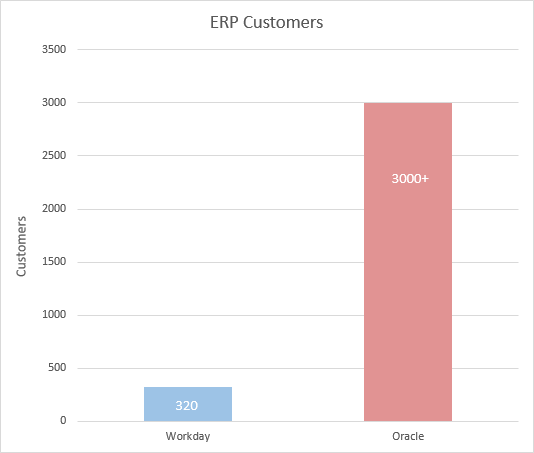
(Taking Oracle’s figures of 3,000+ as 3,000)
Sources:
https://www.constellationr.com/blog-news/insights/key-takeaways-workdays-q4-results
https://www.workday.com/en-us/company/newsroom/press-releases/press-release-details.html?id=2143234
What’s new in Release 12 for OTBI
There’s a lot to like about the improvements in the imminent release 12 applications, however one of the largest jumps forwards is with OTBI – the ad-hoc analysis tool within the Oracle Cloud. Last week I attended a great webinar from Oracle on the enhancements that R12 introduces.
New Subject Areas
As with every release, Oracle have introduced some new subject areas:
Workforce Learning – Learning Management Real Time
For the new learning application you can see which is the most popular learning item, or which is the toughest to complete or who produces the most learning content.
Payroll – Payroll Balances Real Time
Reporting on payroll balances (also back-ported to R11). This enables access to all elements and deductions, and can report on all payroll runs.
Workforce Talent Review – Talent Review Tasks Real Time
Allows reporting on tasks during the talent review cycle, to track the progress of tasks eg. what percentage of workers have completed certain tasks.
Human Capital Management – Approval Notification Archival Real Time
Allows reporting on task approvals that have been completed. There is a time dimension so this is ideal for tracking the number of approvals within certain periods.
Enhancements to existing Subject Areas
Reporting on Managers of Terminated Workers
This is something that has been an issue for one of Cedar’s clients, and this fix will be warmly received by them.
Work Relationship Real Time – Non Primary Work Relationships
Non-primary work relationships now show.
New Dimension – Parent Manager
Within the worker dimension within all subject areas, we now have a number of parent manager name and number fields, allowing us to see the complete manager hierarchy.
New Dimension – Person Schedule Assignment
Allows reporting on an employee’s Work Schedule. This will also be warmly received as we’ve had to create BIP reports for this previously.
New Dimension – Person Schedule Assignment Exception
Allows reporting on exceptions to schedules.
New Dimension – Review Period
Under Performance and Goals, we can now report on the periods associated with performance review.
New Dimension – Criticality
Allows reporting on how critical a job or position is.
New Dimension – Previous Employment
Can contain the worker’s previous employer and the details of that employment.
New Dimension – Talent Score
Exposes the rating scores awarded during a Talent Review meeting.
New Dimension – Technical Post
Report on an employee’s technical posts.
New Dimension – Benefit Legal Disclaimer
Report on Benefits Enrollments that have happened with or without legal disclaimers.
New Dimension – Benefit Person Habits
Tobacco type usage, disability status, medical plan.
New Dimensions – Qualification Plan Participation, Certifications
Enhanced Dimensions – Person Profile Real Time
Added attributes within Licences and Certs, Risk of Loss and Special Projects.
Enhanced Dimensions – Person Names
Additional attributes to allow more names for a worker.
OBI EE Enhancements
Subject Area Search
This is going to save a fair amount of time for those getting up to speed with what’s in each Subject Area.
Save Column As
Easily clone a column. Formatting and formulae are preserved.
New Print and Export Options
HTML 5 style
The default graph style has changed from Flash to HTML5.
It matters where your SaaS is hosted
 In the World of Software as a Service (SaaS) solutions the hosting of the application is taken care of for you. You don’t need to worry where your data is hosted, or which company the hosting is outsourced to, right? That’s probably not the case. You’ll want to take careful notice of what happens to your data.
In the World of Software as a Service (SaaS) solutions the hosting of the application is taken care of for you. You don’t need to worry where your data is hosted, or which company the hosting is outsourced to, right? That’s probably not the case. You’ll want to take careful notice of what happens to your data.
In many cases the company you pay for the service isn’t the one that hosts the servers. An example of this is SAP, who’ve signed a deal to host the SuccessFactors suite on Microsoft’s Azure.
It also appears that Workday might be running DEV and TEST in the IBM Cloud with PROD running in Amazon Web Services.

Finally, Salesforce has been moving their internal infrastructure towards AWS for a while.
SaaS vendors have the choice of either running it on their own Infrastructure as a Service (IaaS) offering, or outsourcing it to someone else. However, the alternatives are shrinking with another cloud provider announcing that they are closing only last month when Cisco decided to shutter their $1bn Cloud.
Of course, any time the responsibility for the success of the service that you’re buying is split over multiple companies – each with their own priorities – it introduces risk. Everything becomes harder for the SaaS vendor to manage, not just in terms of manpower and automation, but security necessarily becomes more complicated. Also, when the SaaS vendor’s deal with one hosting partner ends and they choose to move to another vendor, your servers and data will need to be transitioned over. These are activities that the SaaS vendor DevOps teams will be involved in that don’t enhance your service at all and that you don’t have any choice over.
The SaaS vendor I’ve not mentioned so far is – of course – Oracle. Oracle makes much of owning the complete stack for running a SaaS application. It has its own IaaS business and manages the hosting of all of its SaaS offerings itself rather than outsourcing it to another company. This is clearly a simpler arrangement with no between-company conflicts, leading to a more efficient and more secure solution.
I think it’s clear why this is important and which vendor has chosen the best approach.
Sources:
SAP SuccessFactors moving to Azure
Workday Split between IBM and AWS
Salesforce moves to AWS
Cisco Closes its $1bn Cloud
The Shift to Quarterly Updates
At the start of November Oracle announced that the frequency of the Oracle Cloud Apps application update cycles is changing.
Old – Monthly Updates
Up until now we’ve been working with the monthly update cycle, meaning that on the 1st Friday of every month our test environment(s) get the updates which then flow into Production on the 3rd Friday of each month. The upside of this is that we got our fixes every month, however the downside was that we got our fixes every month! This meant two weeks of testing every month testing and a two week ‘blackout’ period where P2T (Production to Test environment refreshes) could not be scheduled.
So, the calendar would look something like this:

where red days are the Test updates, green days are the Production updates and the purple days are the blackout days. Therefore you could only schedule a P2T on the days that weren’t red, green or purple – which worked out at only 8-9 days per month.
New – Quarterly Updates
We’re now in a world where our updates will mostly come quarterly. Is this a good thing? On balance, yes, it probably is. It certainly means less disruption to customers’ business-as-usual activities, less effort required for testing and it gives more alternatives when trying to schedule P2Ts. The downside is – of course – that the fixes arrive less frequently.
Now the calendar looks more like this:

There are a lot more gaps for P2T refreshes in the new calendar.
But I liked the Monthly Updates …
Oracle have provided a solution for this too, in that if you require monthly updates for a period of time – perhaps during implementation – then you can opt back in to the more frequent release cadence. You can only opt back out to quarterly patches when the next quarterly patch comes around, however, so you can’t just take a single monthly patch.
So, if the quarterly updates are due in February and May, but you want the monthly update in March, then you’ll also have to take the monthly update in April before you can return to the quarterly cadence.
Please note: the infrastructure update cadence (as needed, but approximately quarterly) and the upgrade cadence (once or twice a year) has not changed.
Adoption of the ‘Big 3’ SaaS Suites
Bill Kutik’s regular handicapping of the ‘big 3’ SaaS vendors is an interesting read. The most recent entry can be found here.
Bill goes through each of SAP/SuccessFactors, Oracle and Workday in turn and gives an update on customer numbers however, I think it’s easier to view in a graph:
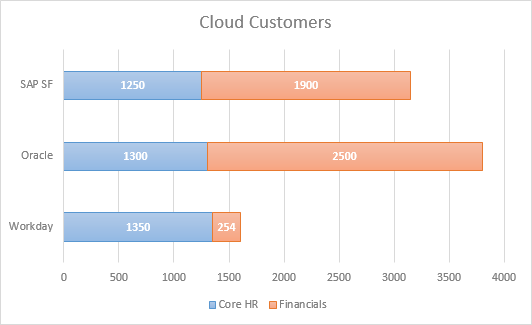
Here we can see that SuccessFactors has 1,250 HCM customers (on Employee Central) and 1,900 on their Financials solution (S/4 HANA ERP).
Oracle is slightly ahead with HCM Cloud Core HR customer numbers, and far ahead with ERP Cloud.
Workday is another 50 customers ahead with their HCM offering, but at a fraction of the customer count on the Financials side.
Also worth noting is that Oracle’s figures are from May 2016, SAP’s from Jun 16 and Workday’s from Sept 16, so this direct comparison is probably unfair to SAP and particularly Oracle as they are likely to have gained new customers in the interim.